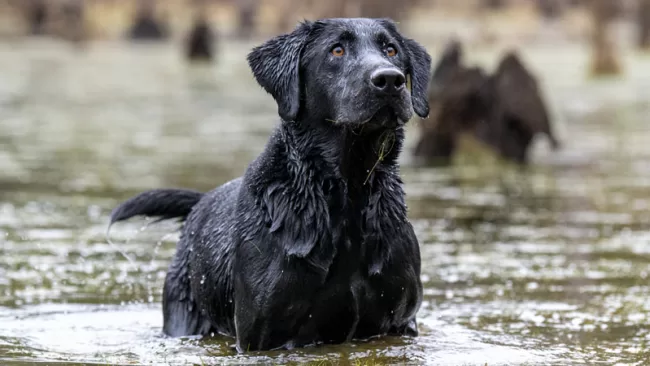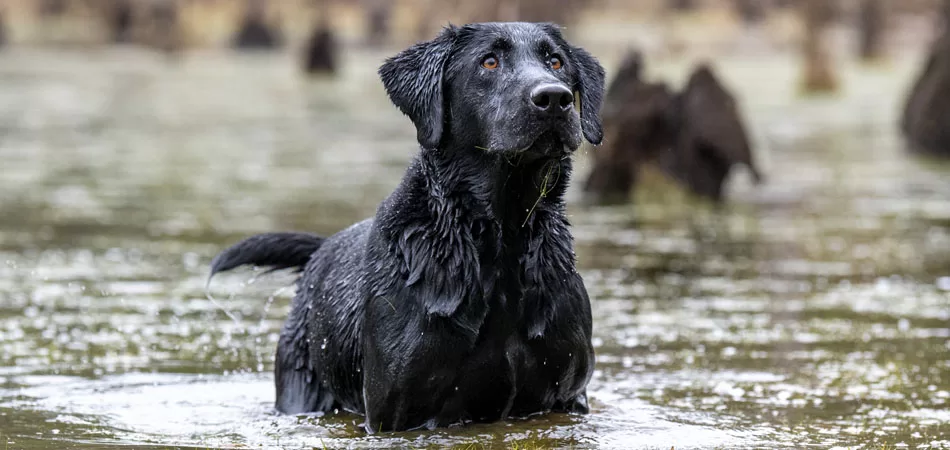Dog Training Timing – Caring for Your Canine Athlete

It’s All in the TIMING
Timing matters – especially when it comes to training, feeding and caring for your hard-working canine athlete and hunting partner. Knowing what to do, when to do it and when to slow down or even stop can keep your hunting dog physically and mentally sound and even more productive in the field.
Timing is both an art and a science according to two experts who work with elite canine athletes on a daily basis.
Dr. Jennell Appel is an expert in canine rehabilitation. She specializes in postoperative rehabilitation, sports medicine, athletic conditioning, and injury prevention. Dr. Appel is based in Georgia during the winter and Wisconsin during summer months, but she’s always mobile with her Sports Medicine Mobile Clinic – a 28-foot unit equipped with state-of-the-art equipment combining the benefits of hydrotherapy and electrical stimulation for pain management. Dr. Appel founded SportVet Canine Rehabilitation in 2013 and provides services to professional retriever kennels and regional and national field trials throughout the year.

“Canine athletes take on stresses that are abnormal,” Dr. Appel says. She notes that hunting dogs can take a pounding while negotiating uneven, rough terrain, busting through heavy cover, leaping over obstacles and stopping on a dime. “The potential for injury is inevitable. It’s not a question of ‘if’ — it’s a question of when. Everything we can do to help prevent injuries is what we should do. That’s where timing plays a role with proper nutrition, proper conditioning, and proper treatment of injuries.”
Jessie Lee Richards owns and operates Full Throttle Kennel in Campbellsport, Wisconsin. She specializes in training retrievers for waterfowl and upland hunting and competes in AKC Hunt Tests and Field Trials. While Jessie has a passion for “full throttle” training and turning dogs into hunting machines, when it comes to training and timing, she believes a common mistake is getting in too big of a hurry. Especially when introducing new experiences and training concepts.

“Every dog is different,” Jessie says. “You need to adjust your pace according to the dog. Don’t rush. If you take the time to do it right the dog will learn and actually develop faster and you won’t have to go backwards and do it all over again.”
Dr. Jennell Appel – known as “Dr. J” to her many clients and friends – and Jessie Richards agreed to tackle various timing considerations from A (when to air dogs) to ZZZZ (allowing time to rest and recover) and everything in between.
To air is humane, to air frequently is divine
A typical day at Full Throttle Kennel starts by letting dogs out to air and eliminate at 6:30 a.m.
“We do chores at 7 and are doing yardwork by 8 and hit the field by 11,” Jessie says. “We are usually done with field work by about 4 p.m. and then feed. We air after feeding and do evening chores and get a bit of a break until 8 p.m., when we turn all the dogs out for another night airing.”
Jessie says that providing numerous opportunities for airing throughout the day plus the timing of the night airing is important. “It makes for a more comfortable dog and a cleaner kennel, which is healthier. When it comes to young puppies, we air even more frequently – probably twice as often. Same goes for airing while traveling with your hunting dog. Stop frequently – every 3-4 hours at a minimum.”
Dr. Appel says it’s important to know your dog and develop a routine. “Dogs that travel constantly are conditioned to eat and air immediately afterward. Whereas a pet dog could eat and perhaps wait an hour or more to eliminate. Know your dog and air accordingly.”
The BEST time for a Vet Check-up?
Make an appointment for your hunting dog at least a month before the hunting season starts.
“A thorough exam in advance of the season makes the most sense because it allows time to address any issues that may be detected,” Dr. Appel says. “For example, if we diagnose tick-borne disease or some other issue you can do something about that versus going to the vet three days before the season starts and finding an issue or illness that causes you to miss the opener. I also recommend getting your dog checked out at the end of the hunting season.”
Timing considerations when feeding hard-working canine athletes
Most experts recommend feeding a high protein, high fat diet like Purina Pro Plan Performance once per day – after exercise and at the end of the day to allow food to be digested and move through the gut before the next day’s hunt.
Dr. Appel agrees with that strategy but adds that timing of feeding can be very dog specific and her recommendation on whether to feed once or twice a day might depend on the dog.
“We definitely have research to show that having the least amount of stool bulk is best for performance dogs and elite canine athletes,” Dr. Appel says. “That means the more time that passes between a meal and a bout of exercise – the better. As a result, a lot of performance dogs are fed once a day. It’s efficient and effective. At the same time, I’ve seen some dogs that are difficult to keep weight on when fed once a day. For those dogs, it makes sense to feed a small amount in the morning and the main meal at the end of the day.”
Jessie Richards follows Dr. Appel’s recommendations and adds that she feeds most of her retrievers once per day except dogs that eat more than 4 cups of Pro Plan per day. “Say you have an active dog with a high metabolism that needs 5 cups of Pro Plan a day,” Jessie says. “With that amount of food, I’d typically feed one cup in the morning a couple hours before doing any work and then 4 cups in the late afternoon at least an hour after doing work.”
Float that kibble
Much like you would add milk to cereal for your breakfast, Dr. Appel advocates adding water to effectively “float” the Purina Pro Plan dry kibble at feeding time.
“Water helps move the food through the stomach quickly,” she says. “What we see in dogs not fed with water or moistened kibble – they will need water about 45 minutes after feeding and tend to really bulk up on too much water. We don’t want a bunch of water sitting in their stomach.”
Dr. Appel has strict timing rules for feeding before – and after — bouts of exercise.
“If you do feed a small amount in the morning, my rule is you need to wait two hours before they work or hunt,” she says. “This is based on pure physiology – transit time of food moving through the stomach is about two hours.”
Even more critical is allowing your dog to cool down after exercise and before feeding at the end of the day.
“I prefer waiting at least an hour after exercise to give the dog time to cool down before feeding,” she says. “What most people don’t realize is that the internal temperature of the dog can be 2-3 degrees higher than what the rectal temperature indicates. As soon as we put food in the dog’s body, the body temperature rises. That food is creating heat inside the body as food is being digested and broken down. That’s why it’s so important to allow the dog to cool down before feeding.”
Puppy time
Jessie Richards offers a “Puppy Head Start” program as part of her training regimen that introduces young dogs to water, birds, obedience and the “boom” and “bang” associated with guns and hunting.
“You want that first experience to be a great experience,” Jessie says.
With introduction to water, Jessie factors in the pup’s age and experience along with the weather.
“If it’s 80 degrees I might take the litter with Mom to the shallow water. When they see Mom get in the water, and me going in, they’re likely to go in – gradually, at their own pace, to join in the fun. Now, if it’s March or October and the water is cold – ugh – no way. That would not be a pleasant introduction.”
Jessie says proper socialization and exposure to all things outdoors help dictate timing. “Expose them to grass and gravel and bushes and other potentially scary things and surfaces. It’s also important to get that retrieving instinct up before you introduce them to water. Let’s say a dog comes in for training at 6 months and hasn’t been in the water. In that case, water isn’t the first thing I’m going to do with that dog. And when I do take them to water, if they don’t want to go in or balk – that’s OK. I’ll come back in a couple days and try it again.”
Likewise, introduction to birds and guns requires patience, pre-work and common sense.
“Before I introduce young dogs to birds, or guns, I’m going to get that retrieving instinct going,” Jessie says. “I’ll use a lot of bumpers. Bumpers aren’t as fun as feathers, and well-bred retrievers are going to like birds. So, we tend to use way more bumpers than birds.”
When the retrieving instinct is up, and the dog is loving bumpers, and a few birds – it’s generally a good time to introduce the gun at a safe distance.
“Our dogs and even puppies are used to hearing guns and noise in the distance,” Jessie says. “Key word here is ‘in the distance.’ You want puppies and young dogs to associate the sound of guns with fun and retrieving. It’s what they love to do.”
Typically Jessie will position an assistant with a cap gun or blank gun in the distance. Jessie has the assistant fire the blank gun at the arc of the throw while the dog is en route to the retrieve.
Time for training and obedience
Training starts the day you get your puppy home, Jessie says.
“Let them be a puppy, but they need to know and understand rules and boundaries. I also believe in introducing pressure and corrections at an early age. By pressure, that’s NOT punishment or pain. It’s that little tug on the flat collar when you say “come” or “here” that puts a tiny bit of pressure on the neck. It’s teaching them to sit and wait at the crate, not leaping out when you open the door. It’s leash pressure, on and off, and teaching them to heel. It’s putting your knee up to block jumping up. That’s how they learn and once they learn, it’s up to you to enforce the rules. If you only enforce rules some of the time, it’s not fair to the dog.”
Time to warm up
Think of a relief pitcher in baseball who goes to the mound without any warm-up tosses and tries to throw a fastball. At best he’s going to get clobbered. At worst, he’s going to hurt his arm.
Most hunters are accustomed to dropping the tailgate, opening the crate and releasing the dog – who is more than happy to hit the ground running. Dr. Appel would highly recommend a little warm-up before going full throttle. “Warming up is really important,” she says. “It’s critical to bring blood flow to all the soft tissues consistently. Think about a dog sitting in the crate on the drive to a hunt, not moving. The heart is supplying blood to the internal organs, but what’s needed is blood flowing to the limbs, the muscles, the external tissues. Before any strenuous exercise I recommend a consistent, fast-paced walk on lead for 5-10 minutes. That would be a good warm-up, before hunting or testing or trialing – with blood going to the extremities.”
Once warmed up, the dog is ready and better prepared to work.
Dr. Appel says taking time to properly condition hunting dogs in the weeks and months before hunting season not only enhances performance, but it can also help reduce or even prevent some injuries.
“It’s not just a matter of being able to get through the hunt or field trial, but a well-conditioned dog at ideal body weight is less likely to suffer injuries. When the body works hard, stresses increase. When muscles are fatigued, the joints and tendons take on more of the stress. Muscles are not supporting the joints as well as they did at maximum capacity. This can lead to tendonitis and other soft-tissue injuries. There’s also fatigue mentally that affects a dogs’ ability to perform. A dog that’s not properly conditioned gets hotter faster. Heat impacts the brain. A hot dog is not thinking clearly. In addition, smelling and scenting capability decreases.”
Time to recover
“Dogs are tough,” Dr. Appel says. “They love to work and love to hunt and tend to want to keep going. By the time a dog is actively showing signs of injury or lameness there’s probably already a significant issue that needs to be addressed.”
Dr. Appel recommends resting the dog for 24 hours at the first sign of an issue and seeking veterinary care if there’s little or no improvement.
“A common mistake is not giving dogs enough time to heal,” she says. “People are anxious and if the situation looks to be improving, they’re eager to go right back to work. The problem is, when a dog is injured, the body will try and find ways to compensate for that injury, shifting weight to other limbs. Now the problem gets worse because that shifting can cause breakdown and injury to other limbs, joints or areas of the body.”
Time to see a specialist
Soft-tissue injuries to tendons, muscles and ligaments are among the hardest issues to resolve.
“Typically, we can manage pain associated with joint injuries and inflammation, but blood flow is needed to heal chronic soft tissue injuries and that takes time,” Dr. Appel says. “Tendonitis might take from one to three months to resolve, while you’re looking at six to nine months for something like an Achilles tendon.”
Dr. Appel recommends finding a certified sports medicine veterinarian with training in rehabilitation and access to technology like diagnostic ultrasound and MRI. Once a proper diagnosis has been made, a rehab plan can be initiated.
“Again, I go back to soft tissue injuries that can come and go. Your dog may not be exhibiting lameness, but that tendon is still healing,” she says. “You have a dog that looks normal but is still healing and that’s where a professional expert can help guide you through timing and the rehab process.”
ZZZZ – Time to Rest
Jessie Richards believes all dogs need a day off once in a while.
“Just like people need time off from work, I think dogs can benefit from a break or a weekend off,” she says. “It’s also important to keep training sessions short and sweet – especially with puppies. You always want to try and end on a positive note. Keep them wanting more.”
Dr. Appel adds that in addition to rest, consideration should be given regarding too much exercise for puppies and potential growth plate issues.
“There’s a tendency to want puppies to mature and progress faster than ever to compete – especially in field trials,” she says. “The more water work you can do with your puppy, the better. Swimming helps improve core strength and creates the least amount of stress on their joints.”
Time to seek professional help?
Going to a pro – either a professional trainer like Jessie Richards or an expert in canine rehabilitation and sports medicine like Dr. Jennell Appel — can help your hard-working dog reach its potential and enjoy more productive and healthy days in the field.
“The average person who works 40 hours a week doesn’t have the time, the equipment, the grounds or the experience a good pro trainer should have,” Jessie says. “It’s an investment in your dog, for sure. But a dog that’s worked a couple times a day is typically going to advance faster and do better than a dog that’s worked a couple times a week.”
And if your dog has an injury or illness that requires advanced diagnostics and the expertise of a certified sports medicine / canine rehabilitation veterinarian– your veterinarian should help you find one.
“The professional with that training and experience can help develop your rehabilitation plan and guide you through that process,” Dr. Appel says.
For more information about Full Throttle Kennel and Training Tips from Jessie Richards, go to www.fullthrottlekennel.com
For more information about SportVet Mobile and Dr. Jennell Appel, go to www.sportvetmobile.com


